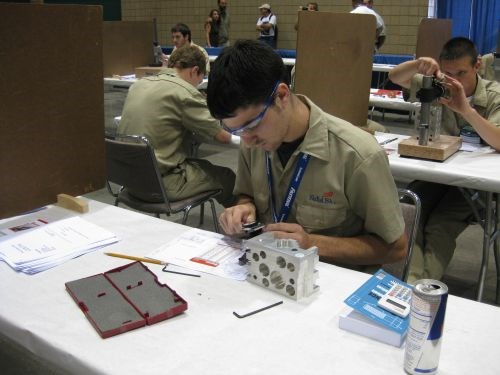Addressing the Skills Shortage
A popular technical education conference and the president’s recent announcement of a new manufacturing training credentialing system provide reason for optimism amid the ongoing shortage of skilled workers.

Students participate in the Precision Machining contest at last year’s SkillsUSA Championships. This photo was provided by cutting tool manufacturer Sandvik Coromant, which, among other industry supporters, will help organize, judge and manage this year’s contests.
No doubt most people aren’t aware that more than 15,000 people have gathered this week in Kansas City, Missouri for the 47th annual SkillsUSA National Leadership and Skills Conference and associated competition. Likewise, President Obama’s recent unveiling of a new system for standardizing manufacturing training credentials has gotten little play in the “mainstream” media, at least as far as I can tell.
Nonetheless, while not quite on par with royal weddings, lewd congressional tweets, “American Idol” snubs or other stories that are virtually guaranteed to send the networks into a veritable feeding frenzy, the lack the lack of skilled workers plaguing the manufacturing industry is a topic likely to be familiar to even those with only a passing knowledge of that sector. And considering the impending baby boomer retirement as well as the fact that thus far, the manufacturing sector has spearheaded what some might refer to as an economic recovery, the importance of this issue isn’t likely to fade any time soon.
The developments mentioned above demonstrate that while efforts to address the skills shortage might fly under the radars of all but the closest followers of the industry, there are reasons for optimism. First, events like the SkillsUSA conference provide young people with a first-hand look at the rewarding, high-paying careers available in manufacturing and other technical fields, as opposed to the stereotypical view of dirty, dangerous assembly-line work with little opportunity for advancement. Judging by the attendance figures, this particular event seems to making an impact. Also, while we’ve got a long way to go in developing the oft-touted “workforce of the future,” it’s always a good sign when government, industry and academia can work together to meet common goals. With the recently unveiled credentialing system, they’ve done just that.
Related Content
-
How to Pass the Job Interview as an Employer
Job interviews are a two-way street. Follow these tips to make a good impression on your potential future workforce.
-
Building Machines and Apprenticeships In-House: 5-Axis Live
Universal machines were the main draw of Grob’s 5-Axis Live — though the company’s apprenticeship and support proved equally impressive.
-
When Handing Down the Family Machine Shop is as Complex as a Swiss-Turned Part
The transition into Swiss-type machining at Deking Screw Products required more than just a shift in production operations. It required a new mindset and a new way of running the family-owned business. Hardest of all, it required that one generation let go, and allow a new one to step in.
















